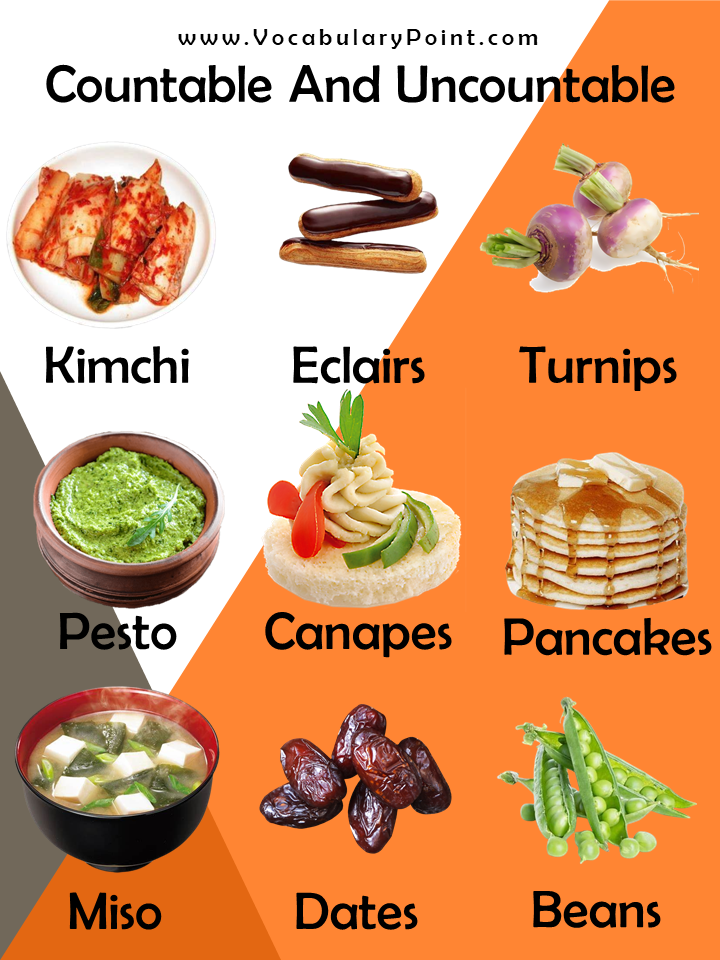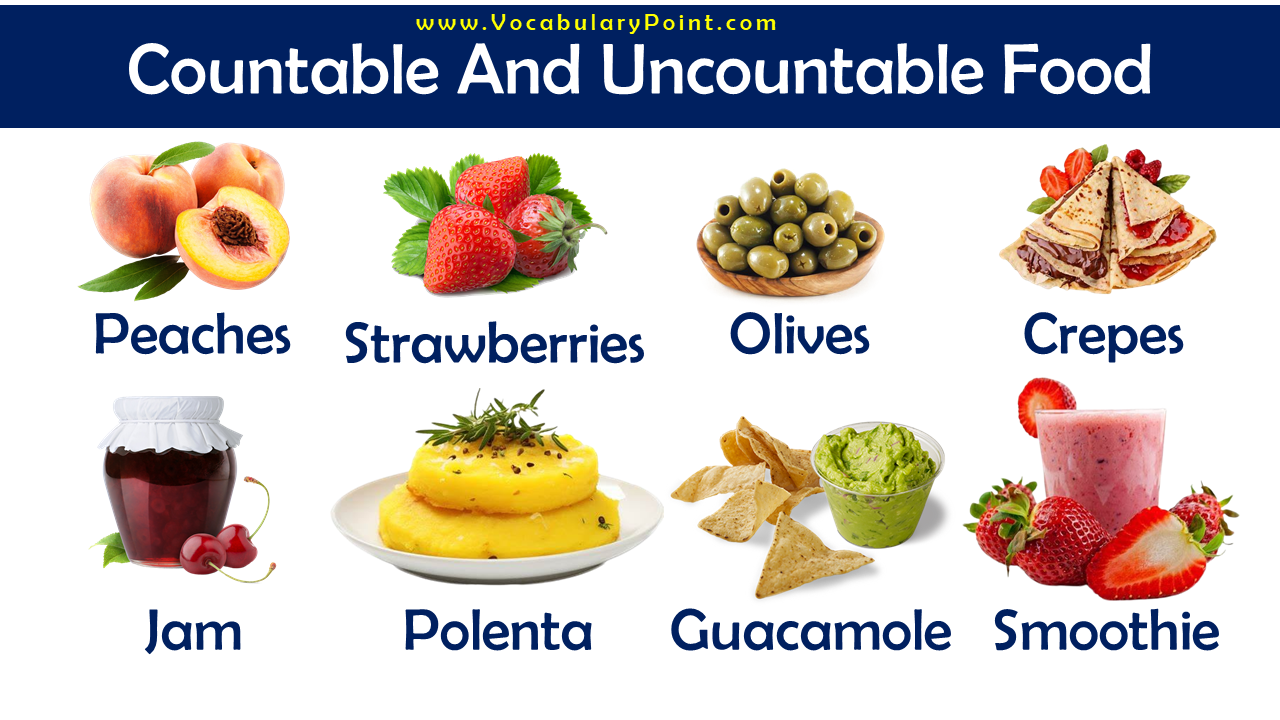In English, foods can be divided into two categories: countable and uncountable food. Countable foods are those we can easily count, such as bananas or cookies, allowing us to use numbers directly before them. On the other hand, uncountable foods, like sugar or butter, are not seen as individual items and require words like “some” or “a piece of” to quantify them.
This distinction helps us communicate more clearly about how much food we’re talking about, making our conversations about recipes or grocery shopping much smoother.
Countable and Uncountable Food
Countable Foods
- Apples
- Bananas
- Carrots
- Sandwiches
- Eggs
- Oranges
- Burgers
- Potatoes
- Cucumbers
- Peaches
- Muffins
- Loaves (of bread)
- Tomatoes
- Chicken breasts
- Bagels
- Pears
- Cupcakes
- Sausages
- Avocados
- Pancakes
- Strawberries
- Onions
- Grapes
- Beans (when counting individual beans)
- Peppers
- Olives
- Cherries
- Meatballs
- Shrimps
- Ribs
- Tacos
- Dumplings
- Pizzas
- Croissants
- Waffles
- Donuts
- Rolls
- Fish (when referring to whole or pieces)
- Steaks
- Wings
- Mushrooms
- Radishes
- Zucchinis
- Kiwis
- Plums
- Lemons
- Limes
- Quiches
- Pies
- Cakes
- Pastries
- Turnips
- Beetroots
- Artichokes
- Figs
- Dates
- Noodles (when referring to individual strands)
- Wraps
- Skewers
- Hot dogs
- Spring rolls
- Slices (of cake, pie, etc.)
- Patties
- Jalapenos
- Garlic cloves
- Baguettes
- Biscuits
- Macarons
- Truffles
- Croquettes
- Bruschettas
- Canapes
- Tarts
- Profiteroles
- Eclairs
- Scones
- Falafels
- Empanadas
- Pierogis
- Crepes
Uncountable Foods
- Rice
- Flour
- Milk
- Honey
- Sugar
- Cheese
- Bread (in general)
- Butter
- Pasta (in bulk)
- Coffee
- Tea
- Meat (in general)
- Salt
- Water
- Oil
- Vinegar
- Mustard
- Jam
- Yogurt
- Ice cream
- Cereal
- Soup
- Porridge
- Chocolate (in general)
- Custard
- Dough
- Sauce
- Gravy
- Salad (mixed)
- Spice
- Curry (dish)
- Stew
- Pudding
- Gelato
- Sorbet
- Mousse
- Tofu
- Quinoa
- Couscous
- Bulgur
- Oatmeal
- Polenta
- Grits
- Hummus
- Guacamole
- Salsa
- Relish
- Chutney
- Ketchup
- Mayonnaise
- Aioli
- Broth
- Stock
- Whipped cream
- Meringue
- Fondue
- Béchamel sauce
- Marinade
- Pesto
- Tapenade
- Smoothie
- Juice
- Beer
- Wine
- Liquor
- Soda
- Matcha
- Syrup
- Miso
- Seaweed
- Tzatziki
- Kimchi
- Sauerkraut
- Cocoa
- Espresso
- Macchiato
- Latte
- Cappuccino
- Mocha
- Frappuccino
Explore More Vocabulary:
(Lunch Food, Drink, Sweets & Deserts, Chocolate, Icecream, Cooking, Food, Texture, Taste, & Beer)

Al Dente
Pasta that is cooked until it is still firm when bitten, ensuring it retains a slight resistance, ideal for many Italian dishes.
Braised
A cooking method where food is first seared at a high temperature and then finished in a covered pot at a lower temperature while sitting in some amount of liquid.
Caramelized
The process of cooking sugar until it becomes a deep amber liquid, used to add a rich, sweet flavor to desserts and some savory dishes.
Deglazed
Adding liquid such as stock or wine to a pan to loosen and dissolve cooked food particles from the bottom, used to create a sauce.
Emulsified
The combination of two ingredients that normally don’t mix together, such as oil and vinegar, to create a homogeneous mixture.
Fermented
A process by which food is exposed to bacteria and yeasts, either naturally or through added cultures, to produce organic acids, gases, or alcohol, enhancing flavor and preserving the food.
Glazed
Coating foods with a glossy mixture to enhance flavor and appearance, often used for meats and pastries.
Infused
Flavoring a liquid by steeping ingredients in it, often used for oils, waters, and spirits to impart subtle flavors.
Julienne
Cutting vegetables, fruits, or cheeses into thin, matchstick-sized strips, commonly used as a garnish or in stir-fries.
Kneaded
The process of working dough to develop gluten, leading to a smooth, elastic texture, crucial for breads and pastas.
Lacto-fermented
A fermentation process that uses lactobacillus bacteria, naturally present in food, to ferment the food in the absence of oxygen, enhancing both flavor and digestibility.
Macerated
Softening or breaking down food by soaking it in a liquid, allowing it to absorb the liquid’s flavor, often used with fruits.
Napped
Coating food lightly with a sauce so that it completely covers the food with a thin, even layer.
Oven-roasted
Cooking food uncovered in an oven, allowing it to develop a crispy, browned exterior while retaining moisture inside.
Poached
Cooking food gently in liquid just below the boiling point, ensuring the food is moist and tender, often used for eggs
Aged
Refers to food that has been allowed to mature under controlled conditions, enhancing its flavor and texture, commonly used for cheeses and wines.
Blanched
A cooking process involving boiling food briefly and then plunging it into ice water, used to preserve color, ease peeling, and remove bitterness from vegetables.
Charred
Cooking on a high heat to achieve a deeply colored, almost burnt exterior, adding a smoky flavor, commonly used for vegetables and meats.
Diced
Cutting food into small, square pieces, typically about 1/4 to 1/2 inch on each side, used for even cooking and as ingredients in salads, soups, and sauces.
Enrobed
Covering or coating food, often sweets such as fruits, nuts, or candies, completely in chocolate or another coating.
Flambéed
A cooking procedure where alcohol is added to a hot pan to create a burst of flames, used to add a rich flavor to the dish.
Gratinated
Baking or broiling a dish with a topping of breadcrumbs or cheese until a crusty layer forms, often used for casseroles and pasta dishes.
Harissa
A spicy and aromatic chili pepper paste with North African origins, made from various peppers, herbs, and spices, used to flavor meats, soups, and stews.
Interleaved
Layering slices of food with seasonings or other ingredients in between, used to enhance flavor and moisture content, such as in gratins or terrines.
Jus
A sauce made from the juices that naturally run from meat during cooking, often enriched with additional stock and reduced to intensify the flavor.
Kombu
A type of edible seaweed, commonly used in Japanese cuisine to make dashi broth, adding umami flavor to soups, stocks, and sauces.
Larded
The process of inserting strips of fat into meats before cooking to add moisture and flavor, traditionally used for lean cuts of meat.
Mirepoix
A mixture of chopped celery, onions, and carrots, used as a base for sauces, soups, and stews to add depth and flavor.
Nutrient-dense
Refers to foods that are high in nutrients but relatively low in calories, containing vitamins, minerals, complex carbohydrates, lean protein, and healthy fats.
Over-kneaded
When dough is kneaded too much, developing the gluten excessively, leading to a tough and chewy baked product.
Pickled
Preserving food by soaking it in vinegar or brine, often with herbs and spices, adding a tangy flavor and extending its shelf life.
Quinoa
A seed that is prepared and eaten similarly to a grain, hailed for its nutritional content, including high protein, fiber, and various vitamins and minerals.
Rendered
The process of melting down fat, typically from pork, beef, or poultry, to separate the fat from connective tissue, used in cooking for added flavor.
Sous-vide
A method of cooking where food is vacuum-sealed in a plastic pouch and then placed in a water bath at a precisely controlled temperature, resulting in evenly cooked food that is juicy and tender.
Tempered
Gradually increasing the temperature of a sensitive ingredient, like eggs or chocolate, to prevent it from cooking unevenly or seizing.
Umami
Describes one of the five basic tastes, alongside sweet, sour, bitter, and salty. It is a savory taste imparted by glutamate, found in various foods like tomatoes, mushrooms, and aged cheeses.
Vinaigrette
An emulsion of oil and something acidic, such as vinegar or lemon juice, used as a dressing or marinade.
Wilted
Slightly cooking leafy vegetables until they are soft and slightly limp, often used in salads or as a side dish.
Xanthan Gum
A polysaccharide used as a food additive and thickening agent, commonly used in gluten-free baking to replicate the binding effect of gluten.
Yeasted
Containing yeast, a leavening agent that causes fermentation, producing carbon dioxide to rise dough for breads, pastries, and other baked goods.
Zucchini Blossoms
Edible flowers from the zucchini plant, often stuffed and fried, offering a delicate flavor and texture, used in gourmet dishes.
Food Vocabulary List
- Appetizer
- Barbecue
- Casserole
- Dumpling
- Entrée
- Frittata
- Gourmet
- Hummus
- Infusion
- Jambalaya
- Kebab
- Legumes
- Marinade
- Nougat
- Orzo
- Pâté
- Quinoa
- Risotto
- Sourdough
- Tofu
- Umami
- Vinaigrette
- Wonton
- Xacuti (a Goan curry)
- Yakitori
- Zucchini
- Bisque
- Chutney
- Daikon
- Emulsion
- Flambé
- Gazpacho
- Harissa
- Icing
- Jerky
- Kimchi
- Lentils
- Mousse
- Naan
- Oxtail
- Paella
- Quiche
- Ragout
- Shakshuka
- Tagine
- Udon
- Velouté
- Wasabi
- Xoconostle (a type of cactus fruit)
- Yuzu
